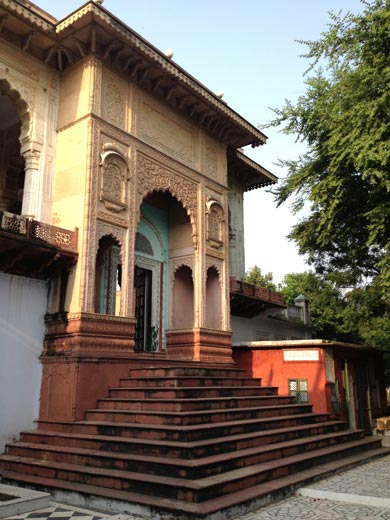Umer Beigh

“For a worm hidden under a rock, the sky is the bottom of the rock.” –Sheikh Ahmad Sirhindi
Kashmir’s connection with Sirhind, a small town in Punjab’s Fatehgarh district that once served as Frontier of Hind or Gateway to India for Mughal invaders, and is home to mausoleum of Sheikh Ahmad Sirhindi (1569-1624) – a revered saint of Naqashbandi order – is an old one.
In order to reach Sirhind town one has to travel through historic Lahore-Delhi highway that connects the town to mainland Punjab.
This road passes amid large flat lush-fields crossing; few bridges, few newly constructed universities, few Gurudwaras and enters inside an old darwaza probably—‘Gateway of Hindustan’.
Before partition, Punjab has been the gateway to the Indian Subcontinent for Central Asia, Iran and Afghanistan.
Earlier, this place would connect Kashmir with the primitive India. After the Richana’s [Buddhist ruler] conversion to Islam in 14th century, the frontier of Kashmir expanded and Sirhind town became an official boundary between the Sultanes of Delhi and Kashmir.
But Sheikh Sirhindi’s mausoleum is different from other mausoleum one would find in the northern Himalayas.
As one enters the shrine, a large board written in both English and Urdu language, warns visitors of do’s and do not’s inside the shrine compound. The sing board, perhaps the only of its kind in India, prohibits visitors from hetrodoxic practices, which otherwise are common in other shrines.
Inside the mausoleum, on the extreme right side of the Sheikh Sirhindi’s final resting place is a mosque with two rooms, built separately. One has to walk carefully as caravans of black ants move on the floor like guardians.
Sheikh Sirhindi, was an orthodox Islamic jurist who advocated the strict adherence of the Islamic law in conjunction with the mystic practice.
Sheikh Sirhindi was from Punjab. His work in 17th century, to the orthodoxic Islamic revival, is referred as ‘exceptional’ in the entire South Asia. He was trained by Kashmir teachers, the descendants of those who were converted by Syed Ali Hamdani, the Islamic preacher.
Unlike unique writings from Subcontinent on Islam and its polity; for example, Awradh-e-Fathiya, Zakhirat-ul-Muluk by Syed Ali Hamdani and Izzalatul Khifa by Shah Wali-ul-Allah, he wrote 536 letters which are compiled as Makhtubat. These letters were written to emperors and other contemporaries of his time.
Sirhindi is believed to have taken a stand against Mughal emperor Akbar, who during his reign, adopted and propagated a new religion called Din-e-ilahi. When Akbar came to know about Sheikh Sirhindi’s opposition he ordered his arrest. It is said that Sheikh Sirhindi spent some time in Gwalior jail on Akbar’s orders.
Historically, Sirhind has been at the centre of the political developments in subcontinent. This place in particular has witnessed several battles. At a time of struggle between the Hindushahi kings and the Turkish rulers of Ghazni, Sirhind was an important outpost on the Eastern Frontier of the Hindushahi Empire.
Sirhind is the oldest name of Fatehgarh district, connected to Pakistan on the west; to Jammu and Kashmir on the northeast and to Haryana and Rajasthan on the southern side. It was the second largest city of the Punjab region and strong fortified town between Delhi and Lahore.
Around four centuries later at Sheikh Sirhindi’s mausoleum, there is no sign of its past violent history. All one could find there is peace and tranquility. Every day hundreds of people from different walks of life, from different faiths, pay their obeisance to Sheikh Sirhindi. It is all together a different experience to see Sikhs and Hindus cleaning the floor of the mausoleum with Muslims.
Interestingly Afghanistan’s ruling family has strong ties with Sheikh Sirhind’s shrine. There are tombs of Afghan ruler Shah Zaman and his queen near the main mausoleum.
One interesting thing that caught my attention was the tradition of writing orisons on the marble walls of the mausoleum and tying wish-threads, which have survived despite strict warnings on the front door. But thankfully this tradition of writing has not impacted the heritage part of the shrine as one could still see some beautiful mosaic work. The shrine is under the GoI as it has been declared as a protected historic monument.
Sirhind town is a mélange of faiths as just half a mile away from Sheikh Sirhindi’s shrine one can see big white dome of Fatehgarh Sahib Gurudwara.
Just a few miles away is another architectural marvel known as Aam Khas Bagh [Daulat Khana-e-Khas], made by Sultan Hafiz Rakhna during Akbar’s rule, that unfortunately lies neglected among maze of newly constructed houses.
During its’ hey days, it is said that Aam Khas Bagh was the main transit point of the Mughal rulers. The place is hardly visited by locals as there are no signboards to guide an enthusiastic history lover.
Interestingly the outer walls of Aam Khas Bagh reminded me of Srinagar’s Koh-e-Maran fort, which has almost same design.
As the day was coming to an end I bid adieu to Sirhind leaving behind glowing domes and tall minarets that this historic town is known for.















